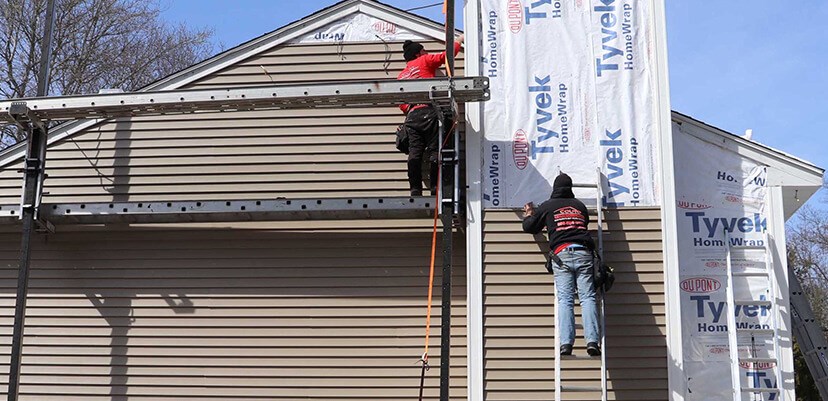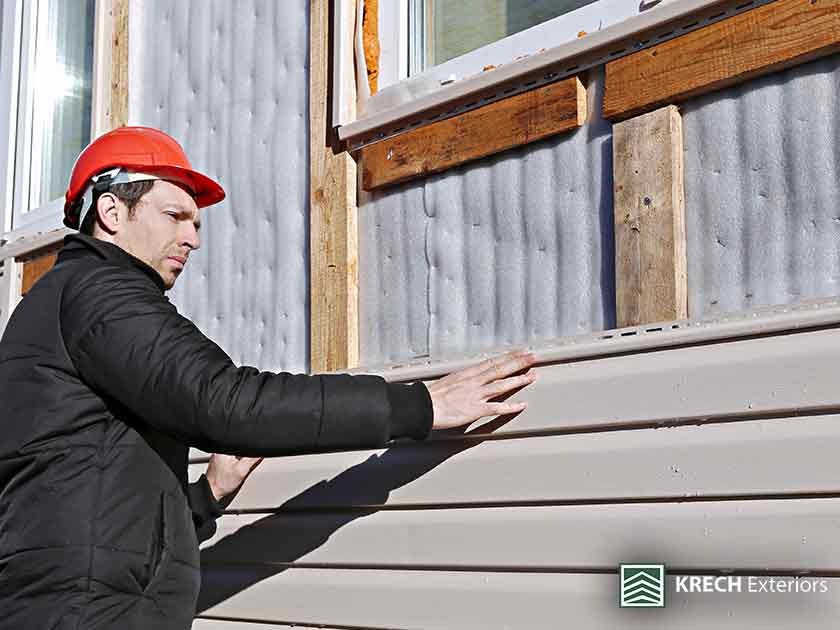Affordable Morris Siding Contractor Offering Superior Craftsmanship
Affordable Morris Siding Contractor Offering Superior Craftsmanship
Blog Article
The Important Overview to the Different Kinds Of Home Siding and Their Distinct Advantages
In the realm of home improvement, selecting the right siding is an important decision that impacts both aesthetic appeal and functional efficiency. With so several alternatives to take into consideration, which house siding product genuinely stands out for your certain job?
Wood Home Siding
Timber exterior siding, a prominent option for domestic exteriors, offers a timeless visual that incorporates all-natural appeal with structural integrity. This siding product is readily available in numerous styles, including clapboard, tiles, and board-and-batten, enabling property owners to customize their façade to match their design choices. Wood exterior siding is generally crafted from durable varieties such as cedar, redwood, or want, which are understood for their resilience and capacity to hold up against environmental stress factors.
One of the primary advantages of timber siding is its superb insulation homes, which can contribute to power efficiency and lower home heating expenses. In addition, wood house siding is biodegradable, making it an eco friendly alternative when sourced sustainably. Regular upkeep, consisting of painting or discoloration, can lengthen its lifespan and improve its appearance, enabling homeowners to protect the all-natural appeal of the timber.
Nevertheless, potential downsides include vulnerability to insects, rot, and climate damages, requiring ample treatment and maintenance - morris siding contractor. Regardless of these concerns, when correctly taken care of, timber siding can supply a sturdy and gorgeous option that improves the personality of a home while offering a warm, inviting environment

Plastic Exterior Siding
Plastic home siding has become a leading selection for property owners seeking a low-maintenance outside choice that combines longevity and price. This flexible product is crafted from polyvinyl chloride (PVC), making it resistant to numerous weather condition conditions, consisting of moisture and UV rays. Consequently, vinyl house siding does not warp, rot, or fade, making certain resilient aesthetic charm.
Among the main advantages of vinyl house siding is its substantial variety of styles and colors, permitting house owners to achieve the preferred seek their property without the requirement for frequent repainting. Furthermore, plastic exterior siding is simple to mount, which can considerably minimize labor expenses throughout construction or remodelling tasks.
Plastic exterior siding likewise contributes to energy effectiveness. Many alternatives feature insulation backing, which improves thermal efficiency, aiding to keep comfy indoor temperatures and potentially lowering energy expenses. In addition, its smooth surface area facilitates easy cleaning, requiring only periodic washing with a garden hose to remove dirt and debris.
Fiber Cement Exterior Siding
Fiber cement siding has gained grip amongst builders and homeowners alike as a result of its impressive mix of longevity and visual adaptability. Composed of a mix of cement, sand, and cellulose fibers, this home siding choice is engineered to hold up against severe weather condition conditions, consisting of high winds, hefty rain, and temperature level variations, making it a you can check here durable option for domestic exteriors.

One of the key benefits of fiber concrete siding is its resistance to parasites, such as termites, and its non-combustible nature, offering improved fire safety and security. morris siding contractor. Additionally, it is readily available in a large array of designs, shades, and structures, enabling home owners to achieve their desired visual without compromising performance
An additional advantage is its reduced maintenance needs; fiber concrete exterior siding typically needs paint or discoloration every 5-10 years, which is much less frequent than other materials. Its long life contributes to a lower overall cost of ownership, as it decreases the demand for constant fixings or replacements.
Ultimately, fiber cement exterior siding stands for an exceptional financial investment for those seeking a resilient, appealing, and versatile outside option, combining both form and function to enhance the home's curb appeal.
Steel Siding
The attraction of steel house siding depends on its durable durability and modern visual allure, making it a popular selection for modern design. Offered in materials such as aluminum and steel, steel house siding supplies a variety of coatings and shades, allowing homeowners to attain a customized look that matches their layout vision.

Energy performance is an additional significant benefit, as many steel siding items are designed with insulation options that assist manage web link interior temperatures. This can result in lowered energy expenses with time. Additionally, steel exterior siding is usually recyclable, making it an ecologically pleasant view publisher site option for sustainability-minded property owners.
The setup process for metal house siding can be reasonably uncomplicated, leading to a quicker turnaround time for construction projects. Overall, steel home siding integrates functionality and style, making it a sensible alternative for those looking for a aesthetically appealing and enduring outside surface.
Brick and Rock Exterior Siding
Brick and rock house siding sticks out as an ageless choice that enhances the visual beauty of any type of home. Understood for their toughness and reduced maintenance, these products offer an extraordinary roi while boosting the home's curb charm. Offered in numerous colors, appearances, and patterns, brick and rock can be tailored to match varied architectural designs, from conventional to modern-day.
Among the primary advantages of block and rock exterior siding is their power efficiency. Both products have natural protecting residential properties that help control interior temperatures, possibly reducing cooling and heating expenses. Furthermore, they supply exceptional fire resistance compared to various other house siding options, contributing to improved safety and security.
Another benefit is their durability. Block and rock can last for decades, typically needing marginal maintenance past periodic cleaning. Unlike wood exterior siding, they are unsusceptible bugs and rot, making certain a durable outside that withstands the elements.
Conclusion
In recap, the choice of siding dramatically affects a home's aesthetic allure, energy performance, and maintenance needs. Each type of siding-- whether timber, plastic, fiber brick, steel, or concrete and stone-- offers one-of-a-kind benefits customized to different property owner choices and ecological conditions.
One of the key benefits of timber home siding is its excellent insulation residential properties, which can contribute to energy performance and lower home heating costs. In addition, wood home siding is biodegradable, making it an ecologically pleasant option when sourced sustainably.One of the key benefits of steel siding is its resistance to different ecological elements.Power efficiency is an additional significant advantage, as several metal house siding products are created with insulation alternatives that assist manage indoor temperatures. Each type of exterior siding-- whether timber, vinyl, fiber block, steel, or concrete and stone-- provides one-of-a-kind benefits tailored to different homeowner preferences and ecological problems.
Report this page